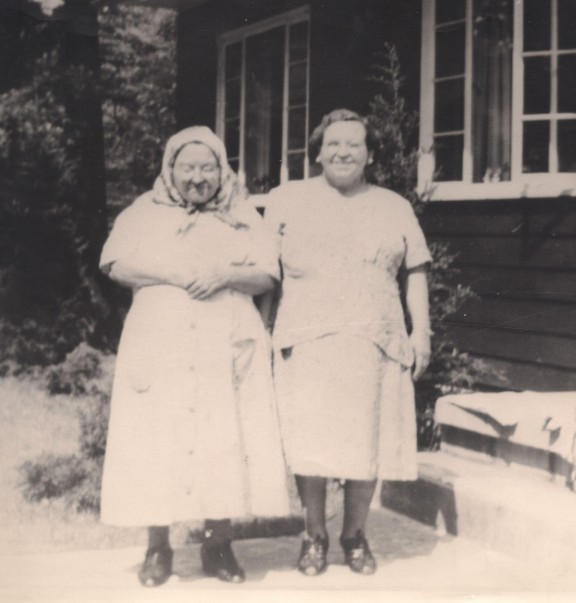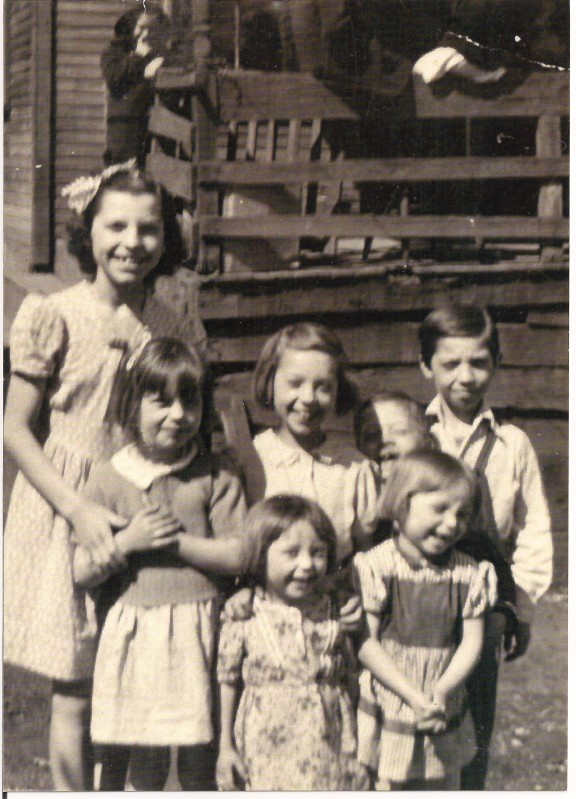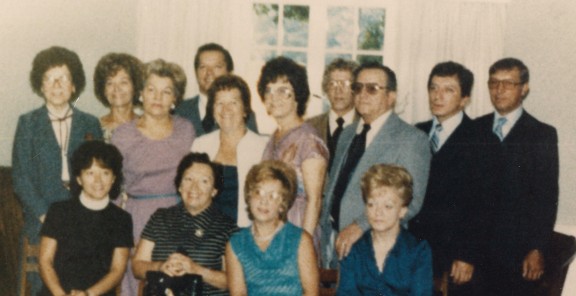|
The Vargulish Family |
| I suppose a great number
of regular shoppers at Jerryís IGA are familiar with two of the ladies who
worked there for many years. Those ladies I refer to just happen to be
sisters who were married to brothers. Their names were Irene Dishman and
Jo Ann Dishman. Both are now retired, and Iíll just bet that most people
assumed as I did that because these women both happen to have a last name
that is pretty well known in this area, more than likely they were native
to these parts. Thatís definitely not the case. Irene and Jo Annís family
ties reach across an ocean to the countries of Czechoslovakia and Austria.
Here are some memories Irene and Jo Ann shared with me about how it was to
grow up as one of fourteen children. Irene and Jo Annís father, Michael Vargulish, was born in Czechoslovakia on November 21, 1893. Not much is known about Michaelís family other than he was raised by an uncle in Czechoslovakia. Irene and Jo Annís mother, Anna Malinish Vargulish, was born in Austria in 1903. Both Michael and Anna were quite young when they boarded a ship to come to America. Annaís motherís name was Mary Malinish, and after arriving in America, she made a home in Oak Grove, Pennsylvania, where she took in boarders. Thatís how Michael Vargulish and Anna Malinish got acquainted. Michael got a room in the Malinish home, and when Anna was just 16 and Michael was 26, they married. Neither Michael nor Anna ever learned to read or write. Soon after they married, they rented a house in Wilpen, Pennsylvania, where Michael worked as a coal miner. The home they lived in had no electricity or running water. As the years went by, they had a total of sixteen children. The first two baby girls died as infants. The other children in the order of their births were: Mary; Helen; Veronica; Elizabeth; Mike, Jr.; Agnes (or Aggie as she was called); Margaret; George; Irene; John; Emma Jean (or Jeannie as she was called); Jo Ann; Charles; and Edward. The Vargulish family were of the Greek Orthodox faith.
|
|
Granny Mary Malinish and
her daughter, Anna Malinish Vargulish, were photographed at the home of
Helen in Rachelwood, Pennsylvania. Helen was the next to the oldest of
the fourteen Vargulish children.
|
| Irene and Jo Ann described
the house they lived in while they were growing up as an older home that
was really hard to heat and very cold in the winter months. At least two
of the girls would walk together to the outdoor toilet, especially after
dark. Every morning, it was always their mother who was the first one to
get up, and on those cold winter days, water left in a bucket in the
kitchen would be frozen. She would be the one to get a fire going in the
coal burning stove that she did all the cooking on. The house had only two
bedrooms. The boys all slept together in one bed, and all the girls slept
together in another. Baths were taken from a big tub filled with water
that sat in the middle of the floor. The children all wore hand-me-down
clothes, and were often made fun of by the other kids they went to school
with because they didnít have what some of the other kids had. All the
Vargulish children walked every where they went because their parents
never learned to drive and never owned a car. They didnít miss school
either just because it snowed. They often walked to the one room school
they attended in the winter months when the snow was quite deep. They
carried their lunch in a brown paper bag. Once in a while they got to go
to a movie in another town some eight miles away, but they had to walk
there. Their mother would go with them on those trips to see a movie.
Irene told me she never had a doll while she was growing up, but Jo Ann
said she and their sister, Jeannie, got to share a baby doll because they
were the youngest of the children. John got a bicycle once, and passed it
down to Jo Ann who rode it to the store to grocery shop. Other than the
usual childhood illnesses, the children were seldom ever sick. The only
major sickness any of them had was when John had to have his appendix
removed at age 7.
Michael Vargulish always raised a big garden to help feed his family every year. After he came home from working in the coal mines in the afternoon, he would finish out his day working in the garden during the spring and summer months. Growing beautiful flowers was something else Anna thoroughly enjoyed. She had a fenced in area for her flower garden that the children were not allowed to play in. Anna was also a really good cook, and even though they couldnít afford many things other families had then, the children always had something good to eat. She was especially good at baking bread and making homemade pasta. The children always got to have a snack of homemade bread and butter when they got home from school in the afternoons. Another of Annaís specialities was homemade noodles. Butter, onions, and honey were added to a lot of the dishes she cooked. In spite of the fact that Anna could not read, her children taught her how to count money so she could do the shopping for the household items she needed. Chores the kids did after they got home from school would be hauling water from the spring to the house, doing the laundry on a rub board and hanging the clothes out on a clothesline in the yard where they would freeze during the cold weather. They kept their milk and butter in the spring house, and both Jo Ann and Irene said they would always be scared to death to go into the spring house in the summer months because snakes would always be in there.
|
|
Some of the Vargulish
children when they were young are shown here. Back row: Elizabeth;
Middle row: Irene; Margaret; John; and George; Front row: Jo Ann and
Emogene Jean. In the background, Agnes stands on the porch.
|
|
Sometimes on their way home from school, they would
visit with their Granny before going on home. The school bus made a stop
right in front of her house. Sometimes during these visits, Granny would
make a mouse out of a handkerchief she carried, and she would ask the
kids to come pet the mouse. But the mouse would always end up jumping at
them when they came over to pet it. Granny loved this little game she
played with the children. A nearby neighbor had goats that were mean,
and many times would chase the children when they came to visit Granny.
Their only escape would be to run and get behind Grannyís screen door to
avoid being attacked by the goats.
If any occasion ever came up that their parents and Granny wanted to carry on a conversation in front of the children that they didnít want them to understand, they would always speak their native language, Slavic. The children could only wonder what was being said when these conversations took place. The observance of Christmas was different in the Greek Orthodox faith. Christmas Eve was always celebrated on January 7th, and Easter was observed about seven weeks later than the traditional date for Easter. Anna always prepared a very special meal for their Christmas Eve that did not include meat. Fish, beans, and potatoes would be included in that meal. Even today, Emogene Jean continues to follow that tradition. Irene described their childhood by saying they all knew they were very much loved. Although their father didnít outwardly demonstrate his feelings, their mother was very affectionate to all of them, but never showed any favoritism. Even though the children might not have any an abundance of material possessions when they were growing up, one thing their mother did her best to provide was nourishing meals for her family. She made sure they were never hungry. She also encouraged her children to stay in school and get a good education, reminding them of how both their parents never learned to read or write. After Jo Ann left home and got a job in Washington, D.C., working for Blue Cross/Blue Shield insurance, she made her motherís life quite a bit easier by buying her the first washing machine she ever had. Working in the coal mines eventually took itís toll on Michael Vargulish, and as a result, he developed black lung and a really crippling case of rheumatism. After quitting his job in the coal mines, he later got a job in a wild life resort where Helenís husband worked as the manager. He and Anna eventually moved into an apartment in Latrobe, Pennsylvania. He died in 1969 from throat cancer, and in 1981, Anna died following a stroke. Their family grew to include thirty-three grandchildren, and now includes an untold number of additional great-grandchildren etc. At the time of this writing, three of their children have passed away. Those who have died are Agnes, Mike, and Margaret. All died from lung cancer.
|
|
|
|
Itís interesting to note that in this family of fourteen children, four of the sisters each married brothers whose last name was Hutchison, and a fifth sister was engaged to another of the Hutchison brothers, but the engagement ended up being called off. Some years later, Irene and Jo Ann again married brothers, this time the last name was Dishman. Ireneís husband was Hillard, and Jo Annís husband was Rufice. Both Dishman men are now deceased. When we hear names weíre familiar with around here, itís easy to assume that the family roots are connected to this area, but this story is a good example of how that isnít always the case. Both Jo Ann and Irene stressed the fact that each one of them were very good children during their growing up years, and none of them ever gave their parents any problems, something their mother was extremely proud of. And rightly so. That was certainly quite an accomplishment. Despite there being such a large number of children, both Jo Ann and Irene agree they have always been and continue today to be an extremely close knit family. And had their parents not boarded a ship all those years ago to come to America to start a new life, we wouldnít have had the opportunity to learn about the Vargulish family and how it was to be one of a family of fourteen children.
|


